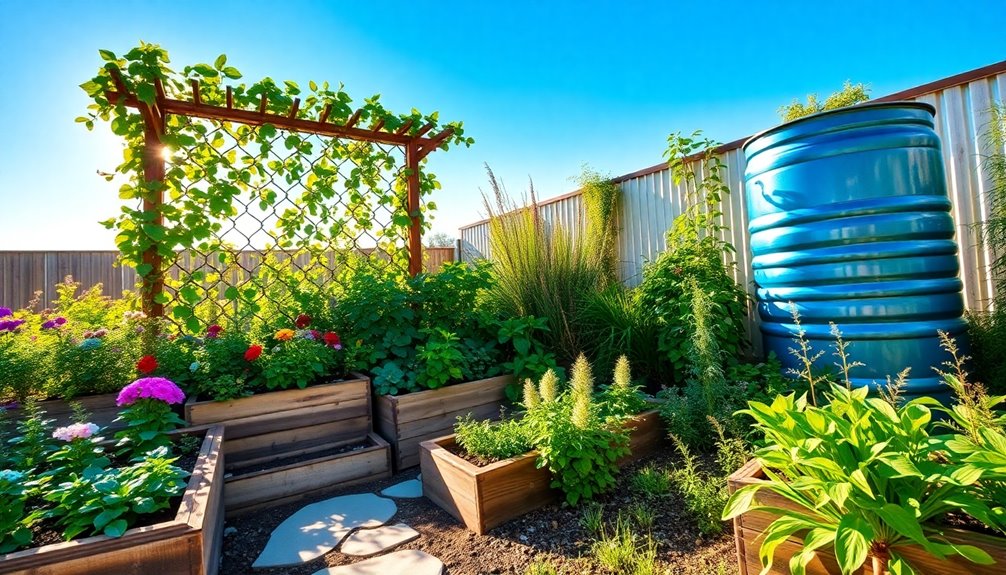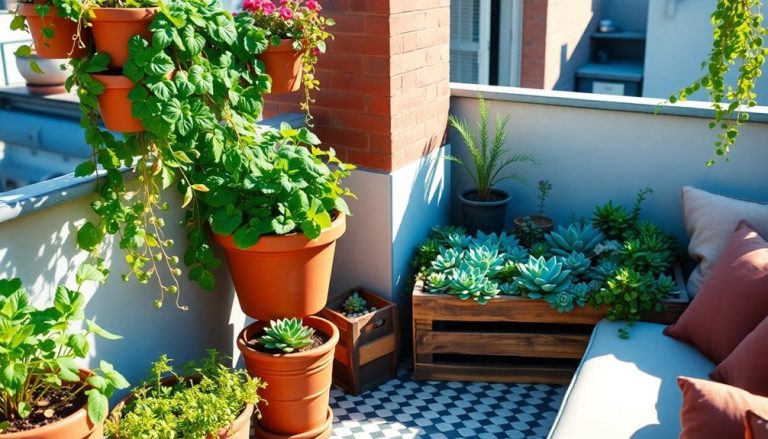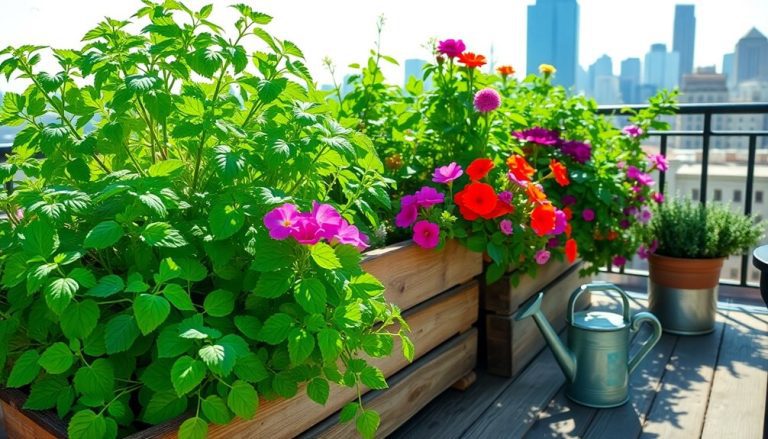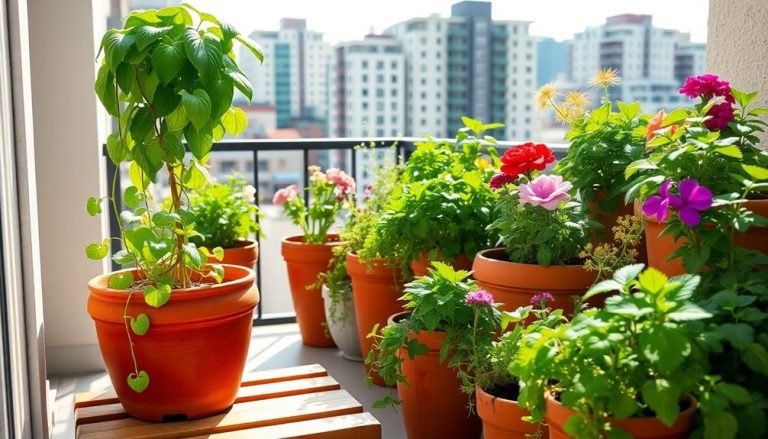To create a stunning eco-friendly garden, start by choosing native plants that thrive in your local climate. This reduces maintenance and water needs while supporting local wildlife. Implement water conservation techniques, like collecting rainwater and using mulch to retain soil moisture. Practice organic gardening by using natural compost and beneficial insects to manage pests. Create wildlife habitats with food sources and shelters, while using sustainable materials like reclaimed wood and local stone for your landscape features. By following these tips, you'll not only enhance your garden's beauty but also its sustainability, and there's so much more to explore beyond these essentials!
Key Takeaways
- Choose native plants to enhance local biodiversity, reduce maintenance, and minimize water usage.
- Implement water conservation methods like rainwater harvesting and drip irrigation for efficient resource management.
- Practice organic gardening by using organic seeds, compost, and beneficial insects for natural pest control.
- Create wildlife habitats with native species, water sources, and shelters to support local ecosystems.
- Use sustainable materials such as reclaimed wood and recycled stone to reduce environmental impact and enhance garden aesthetics.
Choose Native Plants

When it comes to creating an eco-friendly garden, why not start with native plants? These plants are adapted to your local climate and soil conditions, making them easier to grow and maintain. By choosing native species, you'll save time and effort—no need for excessive watering or chemical fertilizers, which can harm the environment.
Native plants provide essential habitats for local wildlife, including birds, butterflies, and beneficial insects. You'll attract pollinators to your garden, enhancing biodiversity and contributing to a healthier ecosystem. Additionally, incorporating edible flower seeds can add both beauty and functionality to your garden, allowing you to enjoy the benefits of both aesthetics and culinary delights.
Plus, these plants often resist pests and diseases better than non-native varieties, reducing your reliance on pesticides. In fact, some native plants, such as citronella and lavender, can also help naturally repel insects, further protecting your garden's ecosystem. Selecting native plants also means you'll enjoy vibrant colors and seasonal changes that reflect your region's natural beauty.
You can create a stunning landscape that requires less maintenance while supporting local flora and fauna. Before you start planting, research the native species suitable for your area.
Visit local nurseries or consult extension services for guidance. By incorporating native plants into your garden, you'll not only create a more sustainable space but also foster a connection with the natural environment around you.
Implement Water Conservation
Implementing water conservation in your garden is essential for creating an eco-friendly space. Start by choosing drought-resistant plants that require less water. These plants thrive in your local climate, reducing the need for irrigation.
Next, consider installing a rainwater harvesting system. This allows you to collect rainwater from your roof, which you can later use to water your plants. Utilizing a wicking system can further enhance your water-saving efforts by providing a slow and steady supply of moisture to your plants.
Another effective method is to incorporate mulch into your garden beds. Mulch helps retain soil moisture, reduces evaporation, and suppresses weeds.
When it comes to watering, do it early in the morning or late in the afternoon to minimize evaporation. Use drip irrigation systems or soaker hoses to deliver water directly to the roots, ensuring it reaches where it's needed most. Drip irrigation systems are designed to use water efficiently, making them a smart choice for sustainable gardening.
Moreover, grouping plants with similar water needs can help you manage your watering schedule more efficiently.
Lastly, monitor your garden's moisture level regularly; this way, you'll know when to water and when to let your plants be. By implementing these water conservation techniques, you'll not only save resources but also promote a healthier garden ecosystem.
Practice Organic Gardening

Embrace organic gardening to cultivate a healthier garden and environment. By using natural methods and materials, you'll reduce chemical runoff and promote biodiversity.
Start by selecting organic seeds or plants, which are grown without synthetic pesticides or fertilizers. This approach not only supports your health but also the ecosystem around you.
Next, enrich your soil with organic compost. Composting kitchen scraps and yard waste creates a nutrient-rich amendment that boosts soil health and fosters beneficial microorganisms. Investing in a quality compost bin product can streamline this process and maximize efficiency.
Additionally, practice crop rotation to prevent pest buildup and maintain soil fertility.
Control pests naturally by introducing beneficial insects like ladybugs or using organic repellents such as neem oil. These methods are effective without harming the delicate balance of your garden's ecosystem.
Instead of relying on synthetic fertilizers, focus on mulching. This conserves moisture, suppresses weeds, and slowly releases nutrients as it breaks down.
Lastly, embrace companion planting; certain plants can naturally deter pests or enhance growth when planted together.
Create Wildlife Habitats
Creating wildlife habitats in your garden not only enhances its beauty but also supports local ecosystems.
By attracting a variety of species, you contribute to biodiversity and create a thriving environment.
Here are some simple ways to transform your garden into a welcoming haven for wildlife:
- Plant native species: Choose plants that are indigenous to your area; they provide food and shelter for local wildlife.
- Create water sources: Install a small pond, birdbath, or even a shallow dish of water to help birds, insects, and other creatures stay hydrated.
- Add shelter: Incorporate birdhouses, bat boxes, or brush piles where critters can find refuge from predators and harsh weather.
- Reduce lawn area: Replace sections of your lawn with wildflower meadows or native grasses to create more diverse habitats.
- Limit pesticide use: Embrace organic practices to maintain a healthy ecosystem and protect beneficial insects like bees and butterflies.
Use Sustainable Materials

In your pursuit of eco-friendly gardening, using sustainable materials is essential for minimizing your environmental impact. By choosing materials that are renewable, recyclable, or repurposed, you can create a garden that not only looks great but also supports the planet.
Here's a quick overview of sustainable materials you can incorporate:
| Material Type | Benefits | Examples |
|---|---|---|
| Natural Mulch | Reduces weeds and retains moisture | Bark, straw, grass clippings |
| Recycled Stone | Minimizes waste and looks natural | Crushed concrete, bricks |
| Eco-Friendly Paint | Lowers toxins in the environment | Water-based paints |
When selecting hardscaping materials, consider using reclaimed wood for raised beds or pathways. Opt for permeable pavers that allow water to filter through, reducing runoff. You can also choose locally sourced materials to cut down on transportation emissions.
Frequently Asked Questions
How Do I Choose the Right Native Plants for My Region?
To choose the right native plants for your region, research local climate, soil types, and existing ecosystems. Visit local nurseries, ask experts, and consider plants that attract wildlife while thriving naturally in your environment.
What Are the Benefits of Organic Gardening Over Conventional Methods?
Organic gardening boosts soil health, promotes biodiversity, and reduces chemical exposure. You'll enjoy fresher, tastier produce while supporting the environment. Plus, it fosters a deeper connection with nature, making your gardening experience more rewarding and fulfilling.
Can I Create a Wildlife Habitat in a Small Garden Space?
Absolutely, you can create a wildlife habitat in a small garden space! Incorporate native plants, provide water sources, and add shelter like birdhouses or logs. Even a compact space can support diverse wildlife and enhance your garden's beauty.
What Sustainable Materials Are Best for Garden Pathways?
When it comes to creating beautiful pathways, think of using reclaimed wood, gravel, or permeable pavers. They're not just eco-friendly; they'll bring charm while helping the environment thrive. You'll love the transformation!
How Can I Maintain My Garden's Eco-Friendliness Year-Round?
To maintain your garden's eco-friendliness year-round, focus on composting, using native plants, conserving water, avoiding chemical pesticides, and practicing crop rotation. Regularly assess your practices to ensure they're aligned with sustainable gardening principles.
Conclusion
So, you've now got the inside scoop on eco-friendly gardening. By choosing native plants, conserving water, practicing organic gardening, creating wildlife habitats, and using sustainable materials, you'll be on your way to a garden that's not just beautiful but also a veritable utopia for Mother Earth. Who knew saving the planet could be so chic? Just remember, while you're at it, try to avoid turning your garden into a compost heap of guilt for those less eco-conscious!




